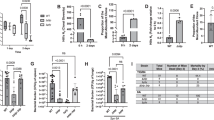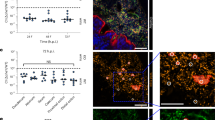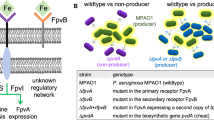Abstract
Competition among microorganisms is a key determinant of successful host colonization and persistence. For Streptococcus pneumoniae, lower than predicted rates of co-colonizing strains suggest a competitive advantage for resident bacteria over newcomers. In light of evolutionary theory, we hypothesized that S. pneumoniae use owner–intruder asymmetries to settle contests, leading to the disproportionate success of the initial resident ‘owner’, regardless of the genetic identity of the ‘intruder’. We investigated the determinants of within-host competitive success utilizing S. pneumoniae colonization of the upper respiratory tract of infant mice. Within 6 h, colonization by the resident inhibited colonization by an isogenic challenger. The competitive advantage of the resident was dependent on quorum sensing via the competence (Com) regulon and downstream choline binding protein D (CbpD) and on the competence-induced bacteriocins A and B (CibAB) implicated in fratricide. CbpD and CibAB are highly conserved across pneumococcal lineages, indicating evolutionary advantages for asymmetric competitive strategies within the species. Mathematical modelling supported a significant role for quorum sensing via the Com regulon in competition, even for strains with different competitive advantages. Our study suggests that asymmetric owner–intruder competitive strategies do not require complex cognition and are used by a major human pathogen to determine ‘ownership’ of human hosts.
This is a preview of subscription content, access via your institution
Access options
Access Nature and 54 other Nature Portfolio journals
Get Nature+, our best-value online-access subscription
$29.99 / 30 days
cancel any time
Subscribe to this journal
Receive 12 digital issues and online access to articles
$119.00 per year
only $9.92 per issue
Buy this article
- Purchase on SpringerLink
- Instant access to full article PDF
Prices may be subject to local taxes which are calculated during checkout




Similar content being viewed by others
Data availability
The in vivo measurements, formatted as used to fit the competition model, are available on figshare at https://doi.org/10.6084/m9.figshare.7166432. The code used to run and fit the population dynamics model, and draw the associated plots, is available at github: https://github.com/johnlees/competition_model (Apache 2.0 license). The code we used to calculate Tajima’s D is available at github: https://github.com/johnlees/tajima-D (GPL 2.0 license). The data that support the findings of this study are available from the corresponding author upon request.
References
Foster, K. R. & Bell, T. Competition, not cooperation, dominates interactions among culturable microbial species. Curr. Biol. 22, 1845–1850 (2012).
Chassaing, B. & Cascales, E. Antibacterial weapons: targeted destruction in the microbiota. Trends Microbiol. 26, 329–338 (2018).
Davies, N. B., Krebs, J. R. & West, S. A. An Introduction to Behavioural Ecology 4th Edn (Wiley-Blackwell, Oxford, 2012).
Clutton-Brock, T. H. & Albon, S. D. The roaring of red deer and the evolution of honest advertisement. Behaviour 69, 145–170 (1979).
Smith, J. M. & Parker, G. A. The logic of asymmetric contests. Anim. Behav. 24, 159–175 (1976).
Leimar, O. & Enquist, M. Effects of asymmetries in owner–intruder conflicts. J. Theor. Biol. 111, 475–491 (1984).
Davies, N. B. Territorial defence in the speckled wood butterfly (Pararge aegeria): the resident always wins. Anim. Behav. 26, 138–147 (1978).
Tobias, J. Asymmetric territorial contests in the European robin: the role of settlement costs. Anim. Behav. 54, 9–21 (1997).
Regev-Yochay, G. et al. Nasopharyngeal carriage of Streptococcus pneumoniae by adults and children in community and family settings. Clin. Infect. Dis. 38, 632–639 (2004).
Kamng’ona, A. W. et al. High multiple carriage and emergence of Streptococcus pneumoniae vaccine serotype variants in Malawian children. BMC Infect. Dis. 15, 234 (2015).
Numminen, E., Cheng, L., Gyllenberg, M. & Corander, J. Estimating the transmission dynamics of streptococcus pneumoniae from strain prevalence data. Biometrics 69, 748–757 (2013).
Lees, J. A. et al. Genome-wide identification of lineage and locus specific variation associated with pneumococcal carriage duration. eLife 6, e26255 (2017).
Pessoa, D. et al. Comparative analysis of Streptococcus pneumoniae transmission in Portuguese and Finnish day-care centres. BMC Infect. Dis. 13, 180 (2013).
Rezaei Javan, R. et al. Genome sequencing reveals a large and diverse repertoire of antimicrobial peptides. Front. Microbiol. https://doi.org/10.3389/fmicb.2018.02012 (2018).
Kono, M. et al. Single cell bottlenecks in the pathogenesis of streptococcus pneumoniae. PLoS Pathog. 12, e1005887 (2016).
Kausmally, L., Johnsborg, O., Lunde, M., Knutsen, E. & Håvarstein, L. S. Choline-binding protein D (CbpD) in Streptococcus pneumoniae is essential for competence-induced cell lysis. J. Bacteriol. 187, 4338–4345 (2005).
Guiral, S., Mitchell, T. J., Martin, B. & Claverys, J. P. Competence-programmed predation of noncompetent cells in the human pathogen Streptococcus pneumoniae: genetic requirements. Proc. Natl Acad. Sci. USA 102, 8710–8715 (2005).
Dorrington, M. G. et al. MARCO is required for TLR2- and Nod2-mediated responses to Streptococcus pneumoniae and clearance of pneumococcal colonization in the murine nasopharynx. J. Immunol. 190, 250–258 (2012).
Zafar, M. A., Wang, Y., Hamaguchi, S. & Weiser, J. N. Host-to-host transmission of Streptococcus pneumoniae is driven by its inflammatory toxin, pneumolysin. Cell Host Microbe 21, 73–83 (2017).
Whiteley, M., Diggle, S. P. & Greenberg, E. P. Progress in and promise of bacterial quorum sensing research. Nature 551, 313–320 (2017).
Shanker, E. & Federle, M. J. Quorum sensing regulation of competence and bacteriocins in Streptococcus pneumoniae and mutans. Genes 8, E15 (2017).
Wholey, W. Y., Kochan, T. J., Storck, D. N. & Dawid, S. Coordinated bacteriocin expression and competence in Streptococcus pneumoniae contributes to genetic adaptation through neighbor predation. PLoS Pathog. 12, e1005413 (2016).
Eldholm, V., Johnsborg, O., Haugen, K., Ohnstad, H. S. & Havastein, L. S. Fratricide in Streptococcus pneumoniae: contributions and role of the cell wall hydrolases CbpD, LytA and LytC. Microbiology 155, 2223–2234 (2009).
Håvarstein, L. S., Martin, B., Johnsborg, O., Granadel, C. & Claverys, J. P. New insights into the pneumococcal fratricide: relationship to clumping and identification of a novel immunity factor. Mol. Microbiol. 59, 1297–1307 (2006).
Croucher, N. J. et al. Diverse evolutionary patterns of pneumococcal antigens identified by pangenome-wide immunological screening. Proc. Natl Acad. Sci. USA 114, E357–E366 (2017).
Croucher, N. J. et al. Dominant role of nucleotide substitution in the diversification of serotype 3 pneumococci over decades and during a single infection. PLoS Genet. 9, e1003868 (2013).
Corander, J. et al. Frequency-dependent selection in vaccine-associated pneumococcal population dynamics. Nat. Ecol. Evol. 1, 1950–1960 (2017).
Azarian, T. et al. The impact of serotype-specific vaccination on phylodynamic parameters of Streptococcus pneumoniae and the pneumococcal pan-genome. PLoS Pathog. 14, e1006966 (2018).
Miller, E. L., Abrudan, M. I., Roberts, I. S. & Rozen, D. E. Diverse ecological strategies are encoded by Streptococcus pneumoniae bacteriocin-like peptides. Genome Biol. Evol. 8, 1072–1090 (2016).
Kerr, B., Riley, M. A., Feldman, M. W. & Bohannan, B. J. M. Local dispersal promotes biodiversity in a real-life game of rock-paper-scissors. Nature 418, 171–174 (2002).
Eswarappa, S. M., Estrela, S. & Brown, S. P. Within-host dynamics of multi-species infections: facilitation, competition and virulence. PLoS ONE 7, e38730 (2012).
Krebs, J. R. Territory and breeding density in the great tit, Parus major L. Ecology 52, 2–22 (1971).
Claverys, J. P., Martin, B. & Håvarstein, L. S. Competence-induced fratricide in streptococci. Mol. Microbiol. 64, 1423–1433 (2007).
Croucher, N. J. et al. Horizontal DNA transfer mechanisms of bacteria as weapons of intragenomic conflict. PLoS Biol. 14, e1002394 (2016).
Eldholm, V. et al. Pneumococcal CbpD is a murein hydrolase that requires a dual cell envelope binding specificity to kill target cells during fratricide. Mol. Microbiol. 76, 905–917 (2010).
Peterson, S. N. et al. Identification of competence pheromone responsive genes in Streptococcus pneumoniae by use of DNA microarrays. Mol. Microbiol. 51, 1051–1070 (2004).
Johnsborg, O., Eldholm, V., Bjørnstad, M. L. & Håvarstein, L. S. A predatory mechanism dramatically increases the efficiency of lateral gene transfer in Streptococcus pneumoniae and related commensal species. Mol. Microbiol. 69, 245–253 (2008).
Peterson, S., Cline, R. T., Tettelin, H., Sharov, V. & Morrison, D. A. Gene expression analysis of the Streptococcus pneumoniae competence regulons by use of DNA microarrays. J. Bacteriol. 182, 6192–6202 (2000).
Marks, L. R., Reddinger, R. M. & Anders, P. High levels of genetic recombination during nasopharyngeal carriage and biofilm formation in Streptococcus pneumoniae. mBio 3, e00200-12 (2012).
Moreno-Gámez, S. et al. Quorum sensing integrates environmental cues, cell density and cell history to control bacterial competence. Nat. Commun. 8, 854 (2017).
Cornforth, D. M. & Foster, K. R. Competition sensing: the social side of bacterial stress responses. Nat. Rev. Microbiol. 11, 285–293 (2013).
Trappetti, C., Potter, A. J., Paton, A. W., Oggioni, M. R. & Paton, J. C. LuxS mediates iron-dependent biofilm formation, competence, and fratricide in Streptococcus pneumoniae. Infect. Immun. 79, 4550–4558 (2011).
Hertzog, B. B. et al. A sub-population of group a streptococcus elicits a population-wide production of bacteriocins to establish dominance in the host. Cell Host Microbe 23, 312–323 (2018).
Zangari, T., Wang, Y. & Weiser, J. N. Streptococcus pneumoniae transmission is blocked by type-specific immunity in an infant mouse model. mBio 8, e00188-17 (2017).
Sung, C. K., Li, H., Claverys, J. P. & Morrison, D. A. An rpsL cassette, janus, for gene replacement through negative selection in streptococcus pneumoniae. Appl. Environ. Microbiol. 67, 5190–5196 (2001).
DeBardeleben, H. K., Lysenko, E. S., Dalia, A. B. & Weiser, J. N. Tolerance of a phage element by Streptococcus pneumoniae leads to a fitness defect during colonization. J. Bacteriol. 196, 2670–2680 (2014).
Kowalko, J. E. & Sebert, M. E. The Streptococcus pneumoniae competence regulatory system influences respiratory tract colonization. Infect. Immun. 76, 3131–3140 (2008).
Hergott, C. B. et al. Bacterial exploitation of phosphorylcholine mimicry suppresses inflammation to promote airway infection. J. Clin. Invest. 125, 3878–3890 (2015).
Zhang, Z., Clarke, T. B. & Weiser, J. N. Cellular effectors mediating Th17-dependent clearance of pneumococcal colonization in mice. J. Clin. Invest. 119, 1899–1909 (2009).
Lemon, J. K., Miller, M. R. & Weiser, J. N. Sensing of IL-1 cytokines during Streptococcus pneumoniae colonization contributes to macrophage recruitment and bacterial clearance. Infect. Immun. 83, 3204–3212 (2015).
Roche, A. M., Richard, A. L., Rahkola, J. T., Janoff, E. N. & Weiser, J. N. Antibody blocks acquisition of bacterial colonization through agglutination. Mucosal Immunol. 8, 176–185 (2015).
Siegel, S. J., Tamashiro, E. & Weiser, J. N. Clearance of pneumococcal colonization in infants is delayed through altered macrophage trafficking. PLoS Pathog. 11, e1005004 (2015).
Blat, J. & Brown, K. J. Bifurcation of steady-state solutions in predator-grey and competition systems. Proc. R. Soc. Edinburgh Sect. A Math. 97, 21–34 (1984).
Allen, L. J. S. A primer on stochastic epidemic models: formulation, numerical simulation, and analysis. Infect. Dis. Model. 2, 128–142 (2017).
Gillespie, D. T. Exact stochastic simulation of coupled chemical reactions. J. Phys. Chem. 81, 2340–2361 (1977).
Allen, E. J., Allen, L. J. S., Arciniega, A. & Greenwood, P. E. Construction of equivalent stochastic differential equation models. Stoch. Anal. Appl. 26, 274–297 (2008).
Maruyama, G. Continuous Markov processes and stochastic equations. Rend. Circ. Mat. Palermo 4, 48 (1955).
Lintusaari, J., Gutmann, M. U., Dutta, R., Kaski, S. & Corander, J. Fundamentals and recent developments in approximate bayesian computation. Syst. Biol. 66, e66–e82 (2017).
Lintusaari, J. et al. ELFI: Engine for Likelihood-Free Inference. J. Mach. Learn. Res. 19, 1–7 (2018).
Gutmann, M. U. & Corander, J. Bayesian optimization for likelihood-free inference of simulator-based statistical models. J. Mach. Learn. Res. 17, 4256–4302 (2016).
Homan, M. D. & Gelman, A. The No-U-turn sampler: adaptively setting path lengths in hamiltonian monte carlo. J. Mach. Learn. Res. 15, 1593–1623 (2014).
Croucher, N. J. et al. Population genomics of post-vaccine changes in pneumococcal epidemiology. Nat. Genet. 45, 656–663 (2013).
Croucher, N. J. et al. Population genomic datasets describing the post-vaccine evolutionary epidemiology of Streptococcus pneumoniae. Sci. Data 2, 150058 (2015).
Tettelin, H. et al. Complete genome sequence of a virulent isolate of Streptococcus pneumoniae. Science 293, 498–506 (2001).
Wernersson, R. & Pedersen, A. G. RevTrans: multiple alignment of coding DNA from aligned amino acid sequences. Nucleic Acids Res. 31, 3537–3539 (2003).
Edgar, R. C. MUSCLE: multiple sequence alignment with high accuracy and high throughput. Nucleic Acids Res. 32, 1792–1797 (2004).
Nguyen, L.-T., Schmidt, H. A., von Haeseler, A. & Minh, B. Q. IQ-TREE: a fast and effective stochastic algorithm for estimating maximum-likelihood phylogenies. Mol. Biol. Evol. 32, 268–274 (2015).
Kosakovsky Pond, S. L. & Frost, S. D. W. Not so different after all: a comparison of methods for detecting amino acid sites under selection. Mol. Biol. Evol. 22, 1208–1222 (2005).
Fu, L., Niu, B., Zhu, Z., Wu, S. & Li, W. CD-HIT: accelerated for clustering the next-generation sequencing data. Bioinformatics 28, 3150–3152 (2012).
Acknowledgements
The authors thank S. Frost and J. Corander for their advice on the formulation of the stochastic model and likelihood-free model fitting, respectively.
Author information
Authors and Affiliations
Contributions
P.S. contributed to project design, experimental work, data analyses and interpretation, and drafting of the manuscript. J.A.L. designed mathematical modelling, carried out all simulations and population genomics, interpreted data, and prepared the modelling section of the manuscript. G.C.W.B. assisted with experimental work. S.P.B. provided assistance on mathematical modelling and drafting of the manuscript. J.N.W. is the corresponding author and oversaw the project conception and design, data interpretation, and manuscript preparation.
Corresponding author
Ethics declarations
Competing interests
The authors declare no competing interests.
Additional information
Publisher’s note: Springer Nature remains neutral with regard to jurisdictional claims in published maps and institutional affiliations.
Supplementary information
Supplementary Information
Supplementary Methods, Supplementary Figures 1–13, Supplementary Tables 1–3, 5 and 6, and Supplementary References.
Supplementary Table 4
Conservation of bacteriocins in the pneumococcal population.
Rights and permissions
About this article
Cite this article
Shen, P., Lees, J.A., Bee, G.C.W. et al. Pneumococcal quorum sensing drives an asymmetric owner–intruder competitive strategy during carriage via the competence regulon. Nat Microbiol 4, 198–208 (2019). https://doi.org/10.1038/s41564-018-0314-4
Received:
Accepted:
Published:
Issue Date:
DOI: https://doi.org/10.1038/s41564-018-0314-4



